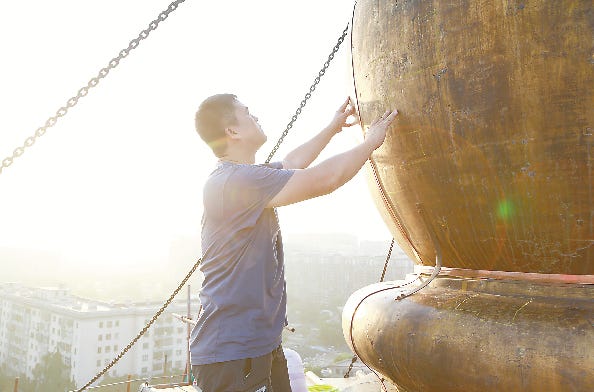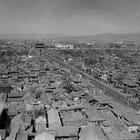Wu Menglin: Memories of Restoring the White Dagoba in Beijing
A personal account of rediscovery, devotion, and Nepal-China heritage at the heart of Beijing’s White Pagoda.
Context: In 1979, during the restoration of Beijing’s White Pagoda, a hidden trove of Buddhist scriptures was discovered. This moment revealed not only sacred texts but also deep historical ties between China and Nepal. Designed in the 13th century by the Nepali artisan Araniko, the pagoda is a powerful symbol of cross-cultural heritage. Wu Menglin(1937-2022), a distinguished expert in China’s cultural heritage protection and one of the experts involved in the restoration, later shared her memories of the experience. Her reflections offer a rare and personal window into the rediscovery of shared traditions, the ethics of preservation, and the quiet dedication behind cultural heritage work.
In a quietly powerful recollection, the late Wu Menglin(吴梦麟), a respected figure in China’s cultural heritage preservation efforts, shared her memories of the 1979 restoration of the White Pagoda at Miaoying Temple(妙应寺) in Beijing. What begins as a technical account of post-earthquake repairs soon unfolds into a deeply human story of discovery, devotion, and the unexpected ways in which China’s past continues to connect with its neighbors, especially Nepal.
Wu began by recalling the aftermath of the devastating Tangshan earthquake in 1976. While attention focused on lives lost and cities destroyed, many of Beijing’s historical structures, particularly tall and fragile ones like pagodas, also suffered significant damage. “The White Pagoda was especially dangerous,” she remembered. “Its upper structure, between the thirteen heavens and the canopy, had been shaken loose. The bricks had flown apart. It was terrifying just to look at.” For Wu and her colleagues, this wasn’t just a matter of architecture. It was a crisis for cultural memory.
While this is the summarized version, it’s an article that provides an important historical perspective on preserving an important cultural heritage that is significant to both Nepal and China. Hence, this article remains freely accessible for all our readers, well-wishers, and subscribers. However, consider going paid with The Araniko Project to access all of our paid contents to help better understand how the world’s superpower interacts with small countries like Nepal.
As the only newsletter in Nepal dedicated to advancing the study of China, we are powered by the support of our readers and well-wishers. Readers can click the subscribe button or can pay through Nepali rupees here:
Its NRS 1000 monthly and NRS 10,000 for a year. Please send us an email once you have confirmed payment.
At the time, Wu was already an experienced figure in the cultural relics field. She described climbing to the top of the pagoda and peering out over the dense urban sprawl of Beijing. From that height, the world looked distant, almost unreal. “Standing up there,” she said, “you could see an old lady on Jinshifang Street(锦什坊街)cooking dinner, and she looked so tiny.” The view underscored how fragile this ancient structure had become and how urgently it needed care.
You can read more about the life around the White Dagoba Temple in our articles
The project, as Wu recalls, was enormous. Over 6,000 bamboo poles were used to construct full scaffolding around the pagoda. She credits the dedication of the workers, especially the young men from the historic architecture division of Beijing’s No. 2 Housing Repair Company. One young worker, barefoot and agile, carried bamboo poles under one arm as he climbed up the towering frame. “Aren’t you afraid you’ll get pricked?” Wu asked. The boy laughed and shrugged it off. “No problem!” It was a moment that stayed with her, a quiet reminder of the spirit behind the restoration.
But the true turning point came on November 1, 1979, a day Wu remembers with clarity. It was a rare day off. She had planned to do laundry and spend time with her child. Then came the call: something had been discovered inside the White Pagoda. Wu rushed to the site with two colleagues. When they arrived, they found that workers had opened the top canopy of the stupa, revealing eight compartments. Each one contained a set of ancient scriptures. These were volumes of the Qianlong Dazangjing《乾隆大藏经》, a massive Buddhist canon from the 18th century, numbering more than 70,000 individual texts.

“The texts were already damaged by time and weather,” Wu says, “but they were unmistakable. Wrapped in yellow covers, each with handwritten characters. We knew instantly this was something sacred.” Her team worked meticulously to remove them. “We used baskets lined with paper and cotton. Every fragment with even a single character had to be preserved. Nothing could be lost.” These scriptures had been hidden for centuries, protected in one of the highest parts of the stupa, known only to a few.
The discovery stirred excitement but also some international concern. Wu explains that Nepal, a country with historical and spiritual ties to the White Pagoda, expressed disapproval at the removal of the scriptures. Their concerns were understandable. The pagoda had been built under the direction of Araniko, a renowned Nepali artisan who arrived in Yuan China in the 13th century. His work had blended Himalayan Buddhist architectural styles with Chinese imperial grandeur, producing a stupa that stood as a symbol of transnational artistry.
Wu is sympathetic to the concerns from Nepal. “Of course they had opinions,” she says, “but we had to explain that the scriptures couldn’t stay up there any longer. The rain was getting in. They were already decaying.” She insists that the team did everything with care and reverence. “We stored them properly, separating the complete texts from damaged ones, and even preserved the tiniest scraps. We didn’t think in terms of economic value. We thought in terms of historical value.”
Her reverence for Araniko is evident throughout her reflections. “He wasn’t just a builder. He was an artist, a craftsman, and a man who bridged cultures.” Wu recounts how Araniko traveled from Nepal to Tibet and eventually to Beijing under the patronage of Kublai Khan. He contributed to imperial architectural works and even participated in the design of astronomical instruments at the Yuan dynasty’s ancient observatory. In Wu’s view, the White Pagoda is not just a Chinese monument. It is a living testimony to Nepal’s contribution to the region’s spiritual and artistic heritage.
Inside the White Pagoda, a statue of Araniko now stands. It is an acknowledgment of his central role in its creation. Wu sees this not just as symbolic but as necessary. “It’s a way of honoring the past honestly. It shows that our history wasn’t made alone, but with help from friends across the Himalayas.”
Among the other artifacts discovered during the restoration were a monastic robe said to have been worn by Emperor Qianlong during his ordination, a monk’s cap, and small gilded statues of longevity Buddhas(长寿佛) and the Three Buddhas of Past, Present, and Future(三世佛). One object stood out to Wu—a multicolored, tightly wrapped volume that resembled a zongzi(粽子), glutinous rice stuffed with a range of fillings and wrapped in bamboo leaves, from childhood. “We didn’t know what was inside. Someone later claimed it was a scroll with images of the Buddha. We didn’t touch it. We felt we didn’t have the right to, not without proper approval.”
What made the 1979 restoration truly special, Wu believes, is not just what was discovered, but how it was handled. “In those days, we didn’t rush. We didn’t cut corners. We used traditional materials—lime and hemp, not modern white cement. We let the lime age for three years before use, just like the ancients did.” She contrasts this with later restorations that have, in her view, sacrificed authenticity for speed.
Wu’s narrative is filled with small human moments that bring the past to life: the sounds of wind chimes on quiet Beijing mornings, the old tofu factory nearby that caused disputes over air pollution, or the now-vanished West Gate that once housed a snack shop. She remembers an elderly man named Li Binsheng(李滨生), who lived near the pagoda and frequently dropped by to chat with workers. Even into his nineties, he remained a passionate advocate for preserving a handwritten wartime message found inside the pagoda. This was an emotional letter from 1937, penned by a man named Luo Dejun(罗德俊), who climbed the pagoda during the Japanese invasion and left behind a written cry of anguish for his suffering country.
“This was just a plain sheet of paper,” Wu says, “but to me, it was as valuable as any Qing dynasty artifact. It spoke for the people. It held emotion. It deserved to be preserved.” That letter would later be exhibited at the Museum of the War of Resistance Against Japanese Aggression, offering a reminder that cultural heritage isn’t just about emperors and artisans. It is also about ordinary people trying to leave their mark.
In reflecting on the broader significance of the White Pagoda, Wu speaks with both pride and humility. “This pagoda is the largest domed stupa in China. It was built in 1271, during the Yuan dynasty, and originally part of a great temple called Dasheng Shouwan’an Temple (大圣寿万安寺). Over the centuries, the temple fell into ruin, but the stupa remained.” She notes that by the late Qing period, the temple had become a lively hub for Beijing’s temple fairs, one of the city’s famous Eight Great Temple Festivals.
Yet despite its cultural significance, the pagoda faced many challenges. Pollution from a nearby tofu factory, misguided urban planning, and shifting ground levels all threatened its integrity. Wu even recalls disputes with local officials over a proposal to build a pharmacy at the base of the monument. In those days, the Cultural Relics Bureau had limited power, but Wu and her colleagues persisted. They wrote articles, attended meetings, and did what they could to protect what they loved.
Now, years after her passing, Wu’s reflections continue to resonate. “Many of the people I worked with are gone now,” she had said quietly. “But I still feel it was an honor to be part of that moment. We didn’t just preserve bricks and stones. We preserved memory.”
Wu Menglin was a distinguished expert in China’s cultural heritage protection, especially in Beijing. Over her long career she oversaw and took part in major restoration projects, including the 1979 renewal of the White Pagoda at Miaoying Temple and the 1980s conservation of the North Tower of the Yunju Temple, the Temple of Cloud Dwelling .
As a senior figure at Beijing’s Cultural Relics Bureau, she was deeply involved in the documentation of earthquake damage, installation of lightning rods (like the one on the White Pagoda in 1962), and careful use of traditional techniques in restoration . Colleagues remembered her as meticulous and caring—she stayed in close contact with fellow relic conservators even after retirement
Source: Beijing Municipal Cultural Heritage Bureau, 吴梦麟:追忆1979年白塔寺修缮, https://wwj.beijing.gov.cn/bjww/362760/362765/509143/












Says soo much. Means soo much! Thanks